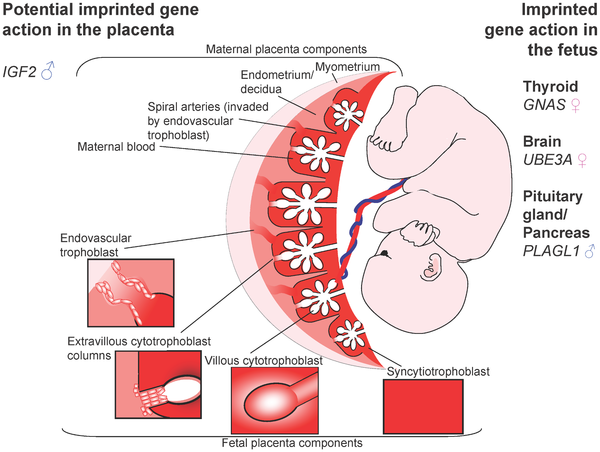File:Placenta potential imprinted genes.png
Placenta_potential_imprinted_genes.png (600 × 452 pixels, file size: 416 KB, MIME type: image/png)
Human Placenta Potential Imprinted Genes
Villous trophoblasts of the human placenta grow as a branched structure, maximising exchange with maternal blood. Extravillous trophoblast invade into the maternal endometrium, and some cells colonise maternal spiral arteries, expanding them to maximise blood flow. ♂ = Paternally expressed; ♀ = maternally expressed.
Imprinted genes are important during fetal growth. Some, such as GNAS, UBE3A, and PLAGL, have physiological impact on the fetus only. Other genes may influence growth in utero via the placenta, or the fetus and placenta. The IUGR seen in SRS, and overgrowth in BWS are suggestive of a role of IGF2 in the human placenta.
Reference
Frost JM & Moore GE. (2010). The importance of imprinting in the human placenta. PLoS Genet. , 6, e1001015. PMID: 20617174 DOI.
Copyright
© 2010 Frost, Moore. This is an open-access article distributed under the terms of the Creative Commons Attribution License, which permits unrestricted use, distribution, and reproduction in any medium, provided the original author and source are credited.
Citation: Frost JM, Moore GE (2010) The Importance of Imprinting in the Human Placenta. PLoS Genet 6(7): e1001015. doi:10.1371/journal.pgen.1001015
Journal.pgen.1001015.g001.png
http://www.plosgenetics.org/article/info%3Adoi%2F10.1371%2Fjournal.pgen.1001015
Cite this page: Hill, M.A. (2024, April 26) Embryology Placenta potential imprinted genes.png. Retrieved from https://embryology.med.unsw.edu.au/embryology/index.php/File:Placenta_potential_imprinted_genes.png
- © Dr Mark Hill 2024, UNSW Embryology ISBN: 978 0 7334 2609 4 - UNSW CRICOS Provider Code No. 00098G
File history
Click on a date/time to view the file as it appeared at that time.
| Date/Time | Thumbnail | Dimensions | User | Comment | |
|---|---|---|---|---|---|
| current | 08:45, 6 August 2010 |  | 600 × 452 (416 KB) | S8600021 (talk | contribs) | Figure 1. The human fetus and placenta. Villous trophoblasts of the human placenta grow as a branched structure, maximising exchange with maternal blood. Extravillous trophoblast invade into the maternal endometrium, and some cells colonise maternal spir |
You cannot overwrite this file.
File usage
The following 2 pages use this file:
